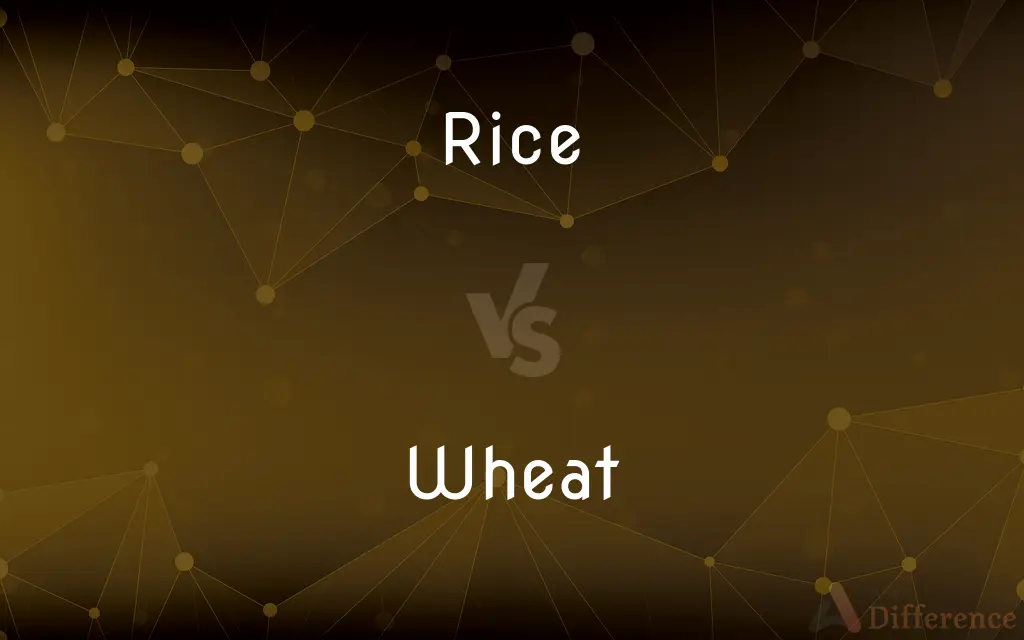Rice vs. Wheat — What's the Difference?
Edited by Tayyaba Rehman — By Fiza Rafique — Updated on September 22, 2023
Rice is a grain primarily grown in wet, marshy environments and is a staple food in many Asian countries. Wheat is a cereal grain grown in temperate zones and is widely used for making bread and pasta.

Difference Between Rice and Wheat
Table of Contents
ADVERTISEMENT
Key Differences
Rice is a cereal grain that is grown mainly in wet, flooded conditions, often in paddies in countries like China, India, and Indonesia. It serves as a major food source in many Asian cultures. Rice is commonly eaten as white or brown grains, either steamed or boiled, and is the base for a variety of dishes including risottos, paellas, and sushi.
Wheat is another cereal grain that is grown in more temperate climates and serves as a staple in many Western countries. Unlike rice, wheat is often ground into flour which is used to make bread, pastries, and pasta. Wheat-based products often undergo various levels of processing and can include many other ingredients.
While rice is primarily associated with Asian cuisine and dietary habits, wheat is more prominent in Western diets. Rice is typically easier to digest and is often recommended for people with digestive issues. On the other hand, wheat contains gluten, which can be problematic for those with gluten sensitivities.
Rice plants are generally shorter and have broader leaves compared to the taller, slender structure of wheat plants. Additionally, rice grains are usually more rounded, whereas wheat grains are more elongated. Rice is often consumed as individual grains, while wheat is usually processed into different forms like flour or semolina before consumption.
Culturally, both rice and wheat have significant roles but in different parts of the world. Rice is often associated with ceremonies and religious rituals in Asia. Wheat has similar cultural significance in the Western world, often symbolizing abundance and fertility.
ADVERTISEMENT
Comparison Chart
Growing Conditions
Wet, marshy
Temperate
Common in
Asian cuisine
Western cuisine
Nutritional Aspect
Easier to digest
Contains gluten
Plant Structure
Shorter with broader leaves
Taller, slender structure
Form of Consumption
Eaten as grains (steamed, boiled)
Often ground into flour
Compare with Definitions
Rice
Staple food in many Asian countries.
Rice is a crucial part of the diet in Japan.
Wheat
Contains gluten, problematic for some.
Gluten-free diets avoid wheat.
Rice
Used in various dishes like sushi and risotto.
Sushi rice must be sticky for the rolls to hold together.
Wheat
A cereal grain grown in temperate climates.
Wheat fields stretch across the Midwest.
Rice
Easier to digest compared to wheat.
Rice is often recommended for people with digestive issues.
Wheat
Staple food in Western countries.
Wheat is a staple in the American diet.
Rice
A grain grown in wet, marshy conditions.
Rice paddies are common in Asia.
Wheat
Used to make flour for bread and pasta.
Wheat flour is the main ingredient in this bread.
Rice
Rice is the seed of the grass species Oryza sativa (Asian rice) or less commonly Oryza glaberrima (African rice). The name wild rice is usually used for species of the genera Zizania and Porteresia, both wild and domesticated, although the term may also be used for primitive or uncultivated varieties of Oryza.
Wheat
Symbolizes abundance and fertility.
Wheat sheaves are a symbol of harvest.
Rice
A cereal grass (Oryza sativa) that is cultivated extensively in warm climates for its edible gn.
Wheat
Wheat is a grass widely cultivated for its seed, a cereal grain which is a worldwide staple food. The many species of wheat together make up the genus Triticum; the most widely grown is common wheat (T. aestivum).
Rice
The starchy gn of this plant, used as a staple food throughout the world.
Wheat
A cereal which is the most important kind grown in temperate countries, the grain of which is ground to make flour for bread, pasta, pastry, etc.
Rice
To sieve (food) to the consistency of rice.
Wheat
Any of various annual cereal grasses of the genus Triticum of the Mediterranean region and southwest Asia, especially T. aestivum, widely cultivated in temperate regions in many varieties for its commercially important edible grain.
Rice
(uncountable) Cereal plants, Oryza sativa of the grass family whose seeds are used as food.
Wheat
The grain of any of these grasses, ground to produce flour used in breads, pasta, and other foods.
Rice
(countable) A specific variety of this plant.
Wheat
(countable) Any of several cereal grains, of the genus Triticum, that yields flour as used in bakery.
Rice
(uncountable) The seeds of this plant used as food.
Wheat
(uncountable) A light brown colour, like that of wheat.
Rice
The types of automobile modifications characteristic of a rice burner.
Wheat
Wheaten, of a light brown colour, like that of wheat.
Rice
A twig or stick.
Wheat
A cereal grass (Triticum vulgare) and its grain, which furnishes a white flour for bread, and, next to rice, is the grain most largely used by the human race.
Rice
A bobbin or spool.
Wheat
Annual or biennial grass having erect flower spikes and light brown grains
Rice
(transitive) To squeeze through a ricer; to mash or make into rice-sized pieces (especially potatoes).
Wheat
Grains of common wheat; sometimes cooked whole or cracked as cereal; usually ground into flour
Rice
(intransitive) To harvest wild rice (Zizania sp.)
Rice
(rare) To throw rice at a person (usually at a wedding).
Rice
To customize the user interface of a computer system, e.g. a desktop environment.
Rice
A well-known cereal grass (Oryza sativa) and its seed. This plant is extensively cultivated in warm climates, and the grain forms a large portion of the food of the inhabitants. In America it grows chiefly on low, moist land, which can be overflowed.
Rice
Grains used as food either unpolished or more often polished
Rice
Annual or perennial rhizomatous marsh grasses; seed used for food; straw used for paper
Rice
English lyricist who frequently worked with Andrew Lloyd Webber (born in 1944)
Rice
United States playwright (1892-1967)
Rice
Sieve so that it becomes the consistency of rice;
Rice the potatoes
Rice
Consumed as steamed or boiled grains.
The rice was perfectly steamed.
Common Curiosities
Is Rice gluten-free?
Yes, rice is naturally gluten-free.
What is Wheat?
Wheat is a cereal grain commonly grown in temperate zones.
What is Rice?
Rice is a grain primarily grown in wet, marshy conditions.
Where is Rice commonly grown?
Rice is mainly grown in Asian countries like China and India.
Where is Wheat commonly grown?
Wheat is widely grown in countries like the United States, Russia, and France.
What dishes commonly use Rice?
Rice is used in sushi, risotto, and fried rice, among other dishes.
How is Rice commonly consumed?
Rice is usually consumed as steamed or boiled grains.
What are the nutritional benefits of Wheat?
Wheat is rich in fiber, protein, and various vitamins and minerals.
Is Rice easier to digest?
Generally, rice is easier to digest compared to wheat.
What foods are made from Wheat?
Wheat is used to make bread, pasta, and pastries.
Can you be allergic to Rice?
Rice allergies are rare but possible.
Does Wheat contain gluten?
Yes, wheat contains gluten.
How is Wheat commonly consumed?
Wheat is often consumed in the form of bread, pasta, and pastries.
Can you be allergic to Wheat?
Wheat allergies are more common and often related to gluten sensitivity.
What are the nutritional benefits of Rice?
Rice provides carbohydrates, small amounts of protein, and various vitamins.
Share Your Discovery

Previous Comparison
Will vs. Trust
Next Comparison
Capricorn vs. AquariusAuthor Spotlight
Written by
Fiza RafiqueFiza Rafique is a skilled content writer at AskDifference.com, where she meticulously refines and enhances written pieces. Drawing from her vast editorial expertise, Fiza ensures clarity, accuracy, and precision in every article. Passionate about language, she continually seeks to elevate the quality of content for readers worldwide.
Edited by
Tayyaba RehmanTayyaba Rehman is a distinguished writer, currently serving as a primary contributor to askdifference.com. As a researcher in semantics and etymology, Tayyaba's passion for the complexity of languages and their distinctions has found a perfect home on the platform. Tayyaba delves into the intricacies of language, distinguishing between commonly confused words and phrases, thereby providing clarity for readers worldwide.
















































